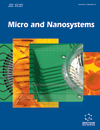
Full text loading...
Uric acid is a key biomarker for diagnosing conditions, such as gout and kidney disorders, highlighting the need for precise and efficient detection methods. Nanomaterial-based biosensors, particularly those utilizing multi-walled carbon nanotubes (MWCNTs), copper oxide (CuO), and direct blue 71 (DB), offer notable advantages due to their exceptional sensitivity and selectivity.
This study aims to design and evaluate an advanced electrochemical sensor for uric acid detection, employing an MWCNTs/CuO/DB nanocomposite. By optimizing the component ratios, the nanocomposite leverages synergistic interactions to achieve a superior performance.
The MWCNTs/CuO/DB nanocomposite was synthesized and characterized using Field Emission Scanning Electron Microscopy (FESEM), Energy-Dispersive X-ray Spectroscopy (EDX), and elemental mapping to confirm its structural integrity and composition. Cyclic Voltammetry was employed to assess the electrocatalytic behavior of the nanocomposite-modified glassy carbon electrode (GCE). The sensor demonstrated a linear response to uric acid concentrations ranging from 100 to 1000 μM, with excellent electrocatalytic activity.
Material characterization revealed a uniform and well-dispersed structure of the MWCNTs, CuO nanoparticles, and DB within the nanocomposite. Electrochemical analyses showed a concentration-dependent response to uric acid, underscoring the sensitivity and reliability of the sensor for biosensing applications.
The MWCNTs/CuO/DB nanocomposite represents a highly promising electrochemical platform for uric acid detection, combining an intricate structure, precise elemental composition, and remarkable electrochemical performance. These findings highlight the potential of integrating advanced nanomaterials into biosensing systems for clinical diagnostics and broader applications in nanotechnology.

Article metrics loading...

Full text loading...
References


Data & Media loading...

